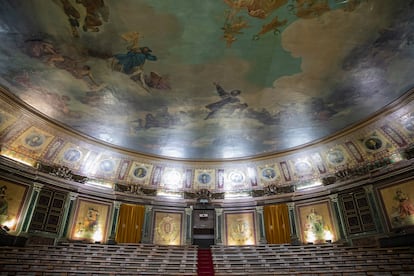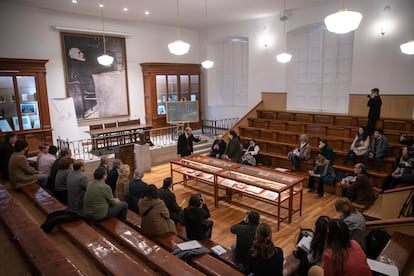The Ministry of Science proposes creating the long-awaited Cajal Museum in the heart of Madrid.

Two milestones in world history occurred just 180 meters apart. The masterpiece of universal literature, Don Quixote , was published in 1605 by María Rivalde 's printing press , located at what is now number 87 on Madrid's Calle de Atocha. On the other side of the street, just a few strides away, the monumental building of the Royal College of Medicine and Surgery of San Carlos was erected in 1834, the medical temple of Spain, destined to bury the era of quacks and quacks. From there emerged the scientific equivalent of Don Quixote : Textura del Sistema Nervosa del Hombre y de los Vertebratas (Texture of the Nervous System of Man and Vertebrates ), the masterpiece of Santiago Ramón y Cajal, winner of the Nobel Prize in Medicine in 1906 for demonstrating that the brain is organized into individual cells, " the mysterious butterflies of the soul ." The Ministry of Science proposed this Friday to establish Spain's twenty-second national museum dedicated to Cajal in this cathedral of science, according to three sources present at a meeting with the authorities involved, the family, and representatives of a dozen scientific institutions.
The Secretary of State for Science, biologist Juan Cruz Cigudosa , explained in the videoconference meeting held this Friday that the Ministry's intention is to display the Cajal Legacy in the mansion. This treasure trove consists of nearly 30,000 pieces, including brain slices, stunning photographs, manuscripts, and the groundbreaking drawings of the Nobel Prize winner and his disciples. This collection is currently housed at the National Museum of Natural Sciences (CSIC) in Madrid. If the Ministry's proposal is successful, the future Cajal Museum will be located right in the heart of the capital's museum scene, declared a World Heritage Site by UNESCO four years ago. The designated location is 20 meters from the Reina Sofía Museum, 375 meters from the Prado Museum, and 600 meters from the Thyssen Museum.
The old Atocha mansion is one of the three great surviving works in Madrid from the reign of Ferdinand VII, along with the Senate and the Royal Theatre. Cajal arrived at this building in April 1892, at almost 40 years old, to become a professor. The imposing grounds had already become the Faculty of Medicine of the Central University, now called Complutense. At its center, a lush pharmacological garden sprouted, with more than 400 medicinal species, such as the white opium poppy . On the edge of a pond for raising frogs stood a rustic house with other animals for vivisections: cats, dogs, rabbits, guinea pigs, mice. In a fenced courtyard, human corpses were macerated and dried in the open air for study. The dead arrived on a cart from the adjacent General Hospital, now transformed into the Museo Nacional Centro de Arte Reina Sofía.
Cajal joined the Atocha mansion from the University of Barcelona, where he had experienced his " fortunate year " in 1888. At the time, the scientific community believed that the cells of the brain and the rest of the nervous system were connected to form a diffuse network, a structure that facilitated the fleeting transmission of thoughts. Armed with his microscope and chicken cerebellums, Cajal presented the first objective evidence that nerve cells were independent entities and transmitted impulses through contact, through "kisses" or "osculi," which seemed to constitute "the final ecstasy of an epic love story ." The German anatomist Wilhelm von Waldeyer named these cells, defined by Cajal, "neurons." In Barcelona, the Spanish scientist confirmed his findings on the retina and spinal cord of birds and mammals, but it was in Madrid, in the Atocha mansion, where he began his assault on the "enigma among enigmas": the monumental human brain, "organ of the soul" and "masterpiece of life."

The dictatorship of Miguel Primo de Rivera led to a stagnation in the Atocha Faculty of Medicine, followed by the tragedy of the Civil War and the postwar purges and decline. The mansion, already decrepit, was abandoned in 1965, after the teaching moved to the University City. It was then that the Illustrious Official College of Physicians of Madrid requested the Ministry of Education and Science to transfer the former faculty to relocate its headquarters there. The transfer, for a third of the surface area, was signed in 1970 for a term of 100 years.
The arrival of the College of Physicians prevented the destruction of the historic part of the building, including its spectacular Great Amphitheater and the intact Cajal classroom , where the professor used colored chalk to draw the neural circuits for his students that would later appear in Don Quixote of Science . The rest of the building bore signs reading "No Entry. Building in Ruins" until restoration work began in 1986 to house the National Institute of Public Administration, attached to the Ministry of Finance. The plan of the department headed by Minister Diana Morant is for the Cajal Museum to share the part of the building occupied by the College of Physicians, with its own and shared spaces, according to sources present at the meeting. The College, embroiled in a legal dispute between two presidential candidates claiming the post following alleged irregularities in the internal elections, has yet to approve the project.
The Cajal Legacy has been in stumbling blocks practically since the researcher's death in 1934. The book Historia del Colegio de Médicos de Madrid (History of the College of Physicians of Madrid ), published by historian Agustín Albarracín a quarter of a century ago, notes that in 1974 there were already "deals to establish the Cajal Museum" in the Atocha mansion. However, tense negotiations between the family, the College of Physicians, and the Spanish National Research Council (owner of the Legacy) bore no fruit for decades. In October 2022, Prime Minister Pedro Sánchez announced that there would be "a museum dedicated to the functioning of the brain" that would begin operations at the end of the Ramón y Cajal Research Year, on May 31, 2025. The mansion was once again the candidate, as EL PAÍS reported .

Cajal's laboratory was "one of the best and, by far, the most capable and important" in the building, according to him. In 1896, he founded his Revista trimenestral micrográfica (Micrographic Quarterly Journal ) there, through which he would communicate his discoveries to the world. On March 1, 1897, he published his laws of the morphology and dynamism of nerve cells: matter saving (establishing the shortest path between two points), conduction time saving (a consequence of the previous one), space saving (avoiding useless gaps), and axipetal polarization, the idea that neurons send their messages with a specific orientation, outward through their extension called the axon.
In 1899, Cajal launched his search for the characteristic elements of the human brain. He compared neurons to trees that formed an “inextricable forest,” so dense that it was impossible to know where and how the roots and branches ended. “Since the adult forest is impenetrable and indefinable, why not resort to the study of the young forest, as it were, in its nursery state?” the researcher proposed. It was easy to obtain newborn animals to analyze their nascent brains, but in humans “it was necessary to overcome or circumvent moral and social prejudices,” as Cajal recounted in his memoirs, entitled Memories of My Life . The scientist went to the Madrid Foundling Hospital in search of corpses. “I can affirm that during a two-year effort, I freely disposed of hundreds of fetuses and children of various ages, which I dissected two or three hours after death and even while still hot. […] In the face of my insistent curiosity, the human brain began to stammer out some of its secrets.”

Between 1899 and 1904, the professor published his Textura del sistema nervious del hombre y los vertebrateas (Texture of the Nervous System of Man and Vertebrates) in Madrid, a colossal 1,800-page work with almost 900 original engravings. "The work of my life," in the words of Cajal, who wished it to be "the trophy placed at the feet of the declining national science and the offering of fervent love rendered by a Spaniard to his despised country." One of the Nobel Prize winner's grandsons, Santiago Ramón y Cajal Junquera, presented a facsimile edition two decades ago with this resounding phrase: "Cajal's Textura is the most important science book written in our country, and every Spaniard, just as he knows and has probably read Cervantes' Don Quixote , should be aware of the existence of this work."
Cajal won the 1906 Nobel Prize in Medicine alongside Italian physician Camillo Golgi , whose method for staining cells with silver nitrate opened the door to the nervous system. The professor retired in 1922, after three decades drawing the structure of the soul with colored chalk on his blackboard. A year later, a new student enrolled in the faculty: Severo Ochoa, who would go on to win the Nobel Prize in Medicine in 1959 for discovering the mechanisms of the biological synthesis of ribonucleic acid. The only two Spanish scientists to win the Swedish prize came from the mansion on Atocha Street.
EL PAÍS




%3Aformat(jpg)%3Aquality(99)%3Awatermark(f.elconfidencial.com%2Ffile%2Fbae%2Feea%2Ffde%2Fbaeeeafde1b3229287b0c008f7602058.png%2C0%2C275%2C1)%2Ff.elconfidencial.com%2Foriginal%2F607%2F26c%2Ffbe%2F60726cfbe31518364db8ed54216df268.jpg&w=1280&q=100)